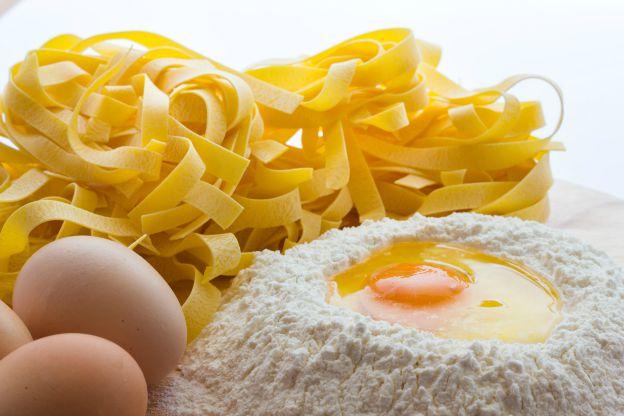Natural and simple ingredients, handicraft and centuries-old traditions which vary from region to region make egg pasta one of the great prides of Italian cuisine. Thanks to its texture, it absorbs and enhances every sauce to perfection.
While egg pasta is part of the culinary tradition of most Italian regions, it is with no doubt the jewel in the crown of the cuisine of Emilia-Romagna, where it originated, and where you can still see the “sfogline” (the women who skillfully knead and roll by hand) at work.

The Basics
The base recipe according to the Emilia-Romagna tradition is 1 egg for every 100 grams of flour, with the optional addition of extra virgin olive oil to make the dough more elastic. Consider, however, that this general guideline may vary according to region, taste and tradition: in Emilia, it is common to use soft wheat flour and more eggs than what the base recipe calls for; in the south of Italy, it is more common to use hard wheat flour and less eggs. What the tradition of Emilia says is that the egg will choose the quantity of flour it needs, meaning that the dough will absorb as much flour as it needs to become firm and elastic, while refusing that in excess.
The golden yellow of the dough, an essential requisite of egg pasta turned out well, depends on the quality of the eggs used. The same goes for the flour: using stale flour can compromise the dough, which will have a tendency to break or crack during the handmade process.

The handmade process
If the quantity of flour and eggs are slightly variable components, the way the ingredients are kneaded is the same for all types of fresh pasta.
Place the flour on a board, make a well in the center and crack the eggs into it (this is called “fontana” – fountain – in Italian), with a pinch of salt. With a wooden fork, beat the eggs and start incorporating the flour with the tips of your fingers. Work the dough with your hands for 15-20 minutes, making sure to mix the ingredients well, until you obtain a dough that is firm, smooth and homogenous. Make it into a ball, cover it with cling film or a damp cloth and let it rest for half an hour. After that, the dough is ready to be rolled into sheets of desired thickness and cut to give it the desired shape. The dough can be rolled by hand, with the rolling pin or with the appropriate pasta machine, called “tirasfoglie”.

Shapes and colors
Fresh pasta comes in many shapes and colors.
Shapes vary according to region. They can be long, such as tagliatelle, traditionally prepared with the rich Bolognese sauce ragù, or fettuccine, delicious with butter and Parmigiano Reggiano or with a porcini mushroom sauce. Tagliatelle and fettuccine are in the same family of tagliolini and pappardelle, the difference among them being in their width: tagliolini are the thinnest, pappardelle the widest. There are short pastas, such as maltagliati, whose name means “badly cut” because they used to be made with the scraps of dough left over from preparing other types of pasta; or garganelli, squares of dough rolled up on themselves, with pointed ends. There is baked pasta, such as lasagna, popular since Roman times, prepared with meat, fish or vegetables, and cannelloni, stuffed with a variety of fillings as well; and there is short, stuffed pasta like tortelloni, classic with ricotta and spinach, and tortellini, which reach their height in broth.
As for color, the base dough of egg pasta can be enriched by adding different types of ingredients, with vegetables being the most common, from the green dough obtained by the use of spinach (typical of Emilia), to the saffron pasta typical of Sardinia, to tomato, carrots, nettles, pumpkin, mushrooms, artichokes, and more. Sometimes, even spices and flavorings like pepper and cocoa may be used.

The dressing will vary according to the type of ingredients used, for example pumpkin-based dough matches well with melted butter, freshly ground pepper and a sprinkling of Parmigiano. Dough colored with tomato can be dressed simply with extra virgin olive oil and some basil leaves, while spinach dough is perfect with melted butter and grated Parmigiano; dough enriched with aromatic herbs is perfect with olive oil and tomato.
Finally, fresh pasta is cooked the same way as dry pasta, but generally takes less time. To avoid sticking during cooking, you may add a spoon of extra virgin olive oil.
Can't get enough of pasta? Check out our Foodie Guide to Pasta.
Want to try your hand at making delicious pasta dishes? Browse our "primi" section in our Recipes page.









